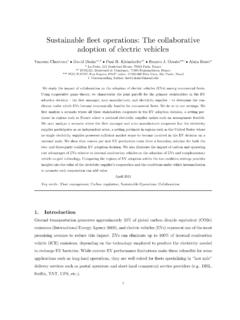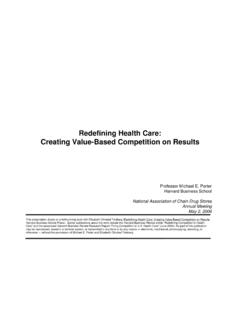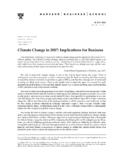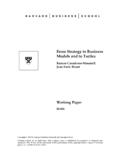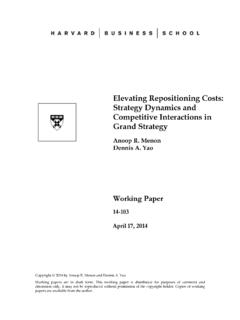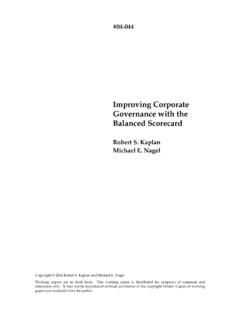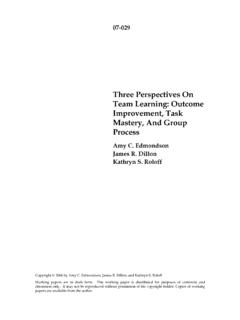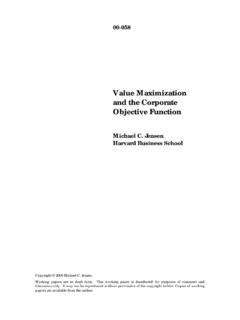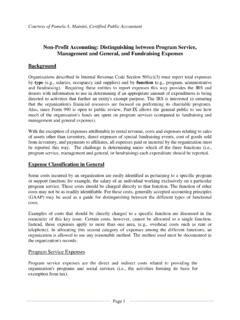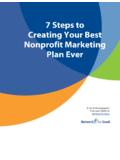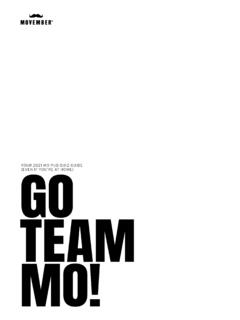Transcription of A Brief Introduction to the Science of Fundraising
1 CASE White Paper Council for Advancement and Support of EducationA Brief Introduction to the Science of FundraisingPrepared by Ashley V. WhillansDepartment of PsychologyThe University of British ColumbiaMay 2016 2016 CASE. All rights reserved. No part of the material in this document may be reproduced or used in any form, electronic or mechanical, including photocopying, recording, posting or distributing, or by any information storage and retrieval system, without the written consent of the copyright of Liability/Disclaimer: While the publisher has used its best efforts in preparing this paper, it makes no representations or warranties with respect to the accuracy or completeness of its contents. Neither the publisher nor the author are engaged in rendering legal, accounting or other professional services.
2 If legal advice or other expert assistance is required, the services of a competent professional should be Europe3rd Floor, Paxton House30 Artillery LaneLondon E1 7 LSUnited KingdomCASE Asia- PacificUnit 05 03 Shaw FoundationAlumni House11 Kent Ridge DriveSingapore 119244 CASE Am rica LatinaBerl n 18 4to piso, Colonia Ju rezC digo Postal 06600, M xico n Cuauht mocM xicoCOUNCIL FOR ADVANCEMENT AND SUPPORT OF EDUCATION1307 New York Avenue, NWSuite 1000 Washington, DC 20005 Brief Introduction to the Science of Fundraising 2016 CASE3 ContentsBroad Overview 4 Executive Summary 4 From Research to Practice: Putting Science to Work in Fundraising 4 Introduction to the Science of Philanthropy 5 Donation Impact: Donors Like to Know They Have Made a Difference 6 Donors Like to Put in Effort and Have Choice over Their Donations 8 Motives Matter: Donors Prefer Messages That Fit Their Values 9 Conclusion 11 Appendix: Impact Information 13 References 14 About CASE 16 About the Author 16A Brief Introduction to the Science of Fundraising 2016 CASE4 Broad OverviewThe purpose of this practitioner report is twofold.
3 The first goal is to provide a Brief overview of the emerging scientific field of philanthropy and to present three critical insights from this field that could benefit Fundraising professionals. The second goal is to promote meaningful discussions between researchers and practitioners. This report can serve as the start of many productive conversations between CASE professionals and scholars regarding best practice and strategies related to SummaryHow can the Science of philanthropy inform day- to- day Fundraising ? This Brief report explores the usefulness of looking to social Science research to enhance Fundraising strategies. Drawing on empirical studies from the disciplines of psychology, sociology and economics, it discusses several potential points of intersection between Fundraising and scholarly research.
4 Specifically, this paper proposes a DIME model to highlight three considerations when crafting Fundraising campaigns: Donation Impact, Motivation and Effort. It also discusses methods to incorporate this research into ongoing Fundraising strategies. Finally, this paper provides recommendations for how professionals can use research to inform Fundraising practices and, more broadly, to bridge the gap between theory and Research to Practice: Putting Science to Work in FundraisingWhether we think of ourselves as Fundraising professionals, scholars or both, the 2014 Amyo-trophic Lateral Sclerosis (ALS) Ice Bucket Challenge got our attention. This campaign, which raised money for the ALS Association, was novel, engaging and quickly spread through social networks making an overnight cause c l bre out of a previously understated charitable cause.
5 In one month, the ALS Association received $ million from more than 739,000 new donors more than doubling the $ million it received during the previous the thought of trying to replicate the success of this Fundraising campaign may seem as challenging as trying to get struck by lightning twice, it is something that can be explained through an emerging field of scholarly research: the Science of philanthropy. By attempting to dis-till the factors that promote success in Fundraising , this field of inquiry seeks to better understand donor motivations and use these insights to inform day- to- day Fundraising Brief Introduction to the Science of Fundraising 2016 CASE5 Introduction to the Science of PhilanthropyThe empirical study of philanthropy that is, the controlled observation and quantitative mea-surement of charitable giving patterns is a relatively new area of scholarly inquiry.
6 Indeed, the term philanthropic studies was not widely recognized until the 1980s when Independent Sector a based coalition of nonprofit organizations, foundations and corporate giving programs began to popularize the scientific study of Fundraising . Shortly afterward, the Center on Philanthropy at Indiana University- Purdue University Indianapolis created two related schol-arly organizations: the Association for Research on Nonprofit Organizations and Voluntary Action (ARNOVA) and the International Society for Third- Sector Research (ISTR). (For a detailed his-tory of the Science of philanthropy, see Katz, 1999.)Today, thanks in large part to the efforts of prominent economists such as John List at the Uni-versity of Chicago, Uri Gneezy at the University of California San Diego and Anya Samek at the University of Wisconsin- Madison, the scientific study of philanthropy continues to thrive.
7 Insti-tutes are springing up at many academic institutions across North America including Boston College, Yale, Stanford and the University of Pennsylvania thereby bringing together multidis-ciplinary scholars to investigate topics related to Fundraising , charitable giving and the recent surge in the scientific study of philanthropy, there remains a sizeable dis-connect between researchers and practitioners. Bridging this gap matters for practitioners and researchers alike. For practitioners, learning about the Science of philanthropy can help guide best practice around crafting charitable appeals, recontacting donors and creating annual campaigns that produce the best return on investment. There are numerous examples in the scientific litera-ture where low- cost and no- cost interventions have yielded significant positive the context of donations to universities, research has revealed that simple framing such as informing donors about seed money being contributed by the university can increase charita-ble donations as much as sixfold.
8 In one study, this information increased donations from $291 to $1,630, a fivefold increase (List and Lucking- Reiley, 2002). Thus, given tighter budgets and increased concerns about overhead, learning about and using academic insights could improve practitioners bottom researchers, learning about the issues faced by practitioners can help them design exper-iments that are relevant for solving real- world Fundraising problems. By working together, it is possible to learn about factors that motivate charitable giving, as well as to implement related practices on a large scale and across the diverse settings encountered by Fundraising profession-als. In the process, it is therefore possible to shed light on how to create and consistently replicate successful campaigns like the Ice Bucket Brief Introduction to the Science of Fundraising 2016 CASE6In the hope of encouraging collaboration between practitioners and researchers, this paper will introduce some of the most valuable insights from the emerging field of philanthropic studies.
9 It will also provide suggestions for how practitioners may use these insights to shape Fundraising a doctoral student who studies the psychological factors that promote charitable giving, I have often acted as an intermediary between Fundraising professionals and the academic research community. The key insights I will present in this paper, described as part of the proposed DIME model (Donation Impact, Motivation and Effort), are my go- to strategies when the charities I work with ask for advice. After describing scientific research that supports the efficacy of each of these insights, I will discuss the practical implications of each report is not meant to provide a comprehensive review of all of the exciting research in this field. Instead, it is meant to provide a springboard for further discussions to lift the fund-raising profession to new heights by standardizing professional practice and therefore ensuring generative, consistent and replicable Fundraising Impact: Donors Like to Know They Have Made a DifferenceAs Fundraising professionals, we care about the impact of our initiatives on the organizations that we work for and with.
10 As researchers, we care about the impact of our research within and beyond the academic context. Unsurprisingly, donors also care about the impact of their charita-ble it turns out, one of the best ways to engage donors is to show them their actions matter. Blood donation organizations often provide donors with a text message each time they have saved a life. Fundraising offices often provide donors with emails documenting the buildings, research and people their donations have supported. Although impact- focused campaigns can sometimes take more effort than business- as- usual recognition efforts, research suggests that these costs are balanced with benefits for both charities and FacilitationWe all like to know that our actions matter. In fact, psychologists have long argued that feeling competent is a fundamental human need.
